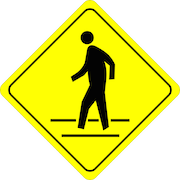 The National Highway Traffic Safety Administration reports that 4,735 pedestrians were killed in traffic crashes in 2013. The agency estimated that 66,000 pedestrians were injured that same year. According to the Centers for Disease Control and Prevention, African-American and Hispanic male pedestrians are more than twice as likely as White men to die in traffic crashes.
The National Highway Traffic Safety Administration reports that 4,735 pedestrians were killed in traffic crashes in 2013. The agency estimated that 66,000 pedestrians were injured that same year. According to the Centers for Disease Control and Prevention, African-American and Hispanic male pedestrians are more than twice as likely as White men to die in traffic crashes.
A study by researchers at the University of Arizona and Portland State University in Oregon may explain the racial disparity in pedestrian traffic injuries. The university study examined whether drivers were more likely to drive safely and yield to people in crosswalks depending on the race of the pedestrian.
The results showed that African Americans on average had to wait 32 percent longer than Whites before drivers would yield to them in crosswalks. The study also found that African Americans were twice as likely as Whites to be passed by multiple vehicles before a driver would yield.
Arlie Adkins, an assistant professor in the school of landscape architecture and planning at the University of Arizona and a co-author of the study, said that “we were surprised to see how quickly the significance showed up. Drivers were clearly displaying behaviors consistent with implicit racial bias.”
The study, “Racial Bias in Driver Yielding Behavior at Crosswalks,” was published in Transportation Research Part F: Traffic Psychology and Behaviour. It may be accessed here.











Not at all surprised at such biases. Have observed inverse of this highly urban, non downtown areàs of big cities with majority populations of color. What else is not being evaluated is the question? Where were each of the injured or killed pedestrians crossing the street? At highly visible locations? Jay walking? Is the fact the minorities are more likely to have jobs that place them crossing the street in the dark or lower visibility? How is each race enculturated & educated on good pedestrian practices? Are well documented factors about access to healthcare and overall health of minorities being considered. Are urban medical response times the same for white and non-white Neighborhoods? Are bias factors at medical facilities affecting quality of care given to minority pedestrian accident victims? Way too many factors not addresses in study to be seeking response yet!!!